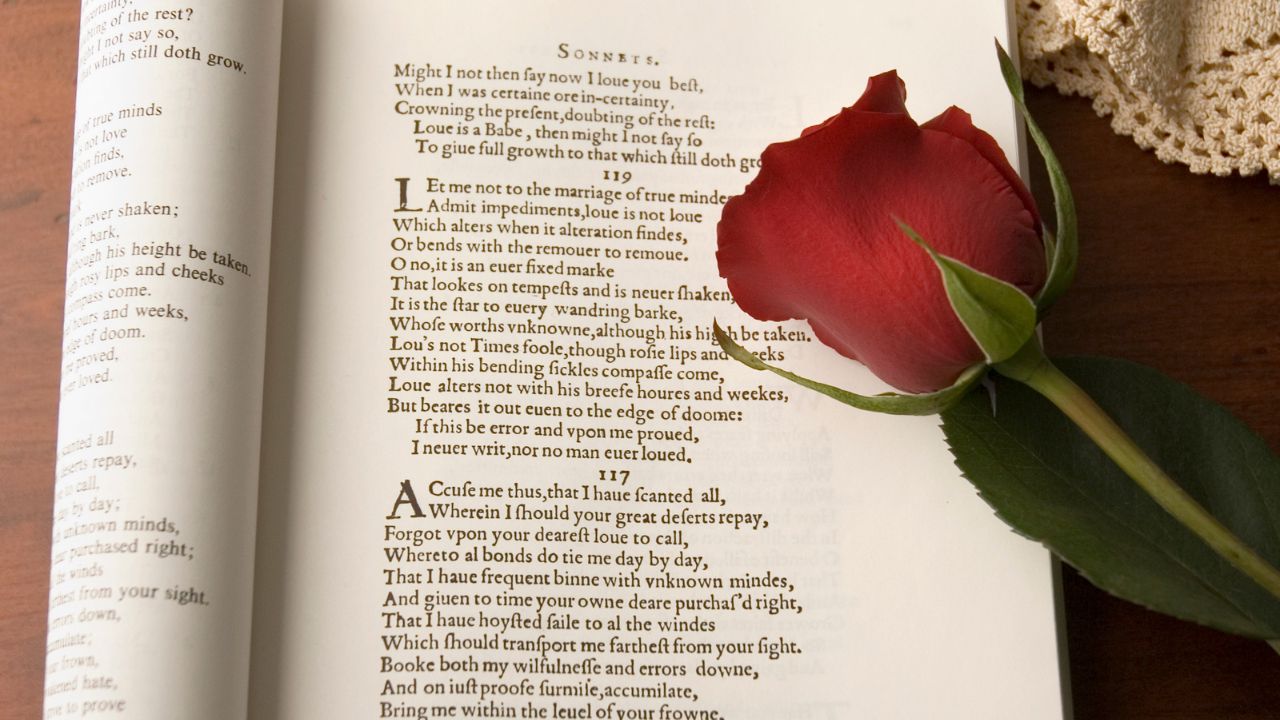Introduction
The sonnet, a poetic form with a rich and storied history, has long been a vehicle for emotional expression and intellectual exploration. Originally developed in Italy during the 13th century, the sonnet has evolved over time and across borders to become a staple of the poetic landscape. In this article, we will take a deep dive into the origins, forms, and examples of this beloved poetry style.
I. Origins
The sonnet’s origins can be traced back to the Italian poet Giacomo da Lentini, a member of the Sicilian School of poetry during the 13th century. However, it was the later Italian poet Petrarch who refined and popularized the form, giving rise to the term “Petrarchan sonnet.” As the sonnet form spread throughout Europe, poets from various countries and languages adapted and transformed it, resulting in a rich tapestry of sonnet styles.
II. Forms
There are three primary forms of the sonnet: the Petrarchan, the Shakespearean, and the Spenserian. Each of these forms is characterized by its own unique structure, rhyme scheme, and thematic content.
1. Petrarchan Sonnet
The Petrarchan, or Italian, sonnet consists of 14 lines written in iambic pentameter. It is divided into two parts: the octave and the sestet. The octave, the first eight lines, typically presents a problem or question, while the sestet, the final six lines, resolves or answers it. The rhyme scheme for the Petrarchan sonnet is typically ABBAABBA for the octave and CDECDE or CDCDCD for the sestet.
2. Shakespearean Sonnet
The Shakespearean, or English, sonnet also consists of 14 lines written in iambic pentameter. However, its structure differs from the Petrarchan sonnet in that it is divided into three quatrains (four-line stanzas) followed by a final rhymed couplet. The rhyme scheme for the Shakespearean sonnet is ABABCDCDEFEFGG. The quatrains often develop a theme or idea, while the final couplet serves as a conclusion or epigrammatic statement.
3. Spenserian Sonnet
The Spenserian sonnet, named after the English poet Edmund Spenser, is a variation of the Shakespearean sonnet. Like the other forms, it contains 14 lines of iambic pentameter, but it employs a unique rhyme scheme of ABABBCBCCDCDEE. The Spenserian sonnet is characterized by a more intricate interlocking rhyme scheme, which links the quatrains to one another, creating a sense of continuity and progression throughout the poem. This form is particularly well-suited for extended sequences of interconnected sonnets, as seen in Spenser’s “Amoretti.”
III. Examples
To illustrate the beauty and versatility of the sonnet form, we will examine examples from each of the three primary styles:
1. Petrarchan Sonnet
Petrarch's Sonnet 190:
"Passa la nave mia colma d'oblio"
("My ship, full of forgetfulness, sails on")
The octave:
Passa la nave mia colma d'oblio
per aspro mare a mezza notte il verno
entro le due più alte e ferme torri,
che mai non chiuser, non aperir, catena.
La Sirena cantando il dolce guerno
ne l'acque il mar con l'aria fa discorri,
e sé stessa dal sonno par che desti
che sparge in grembo alle sue Madri il fior.
The sestet:
Ma pur, Signora, il laccio si rinforza,
ché 'l vento, ch'al mio legno accresce foco,
la vela inchina e 'l timon scoperchia;
E non pur i duo lumi, ma la forza
di lor dolcezza il cor m'ha messo in gioco,
tanto ch'i' temo omai de la gran perca.
English Translation of Petrarch's Sonnet 190
My ship, laden with forgetfulness, sails on
Through the harsh sea, at midnight, in the winter,
Between the two tallest and firmest towers,
Which never closed, nor opened, chain.
The Siren sings her sweet lullaby,
In the waters, the sea converses with the air,
And from slumber, it seems she wakes herself,
Spreading flowers in the lap of her Mothers.
But still, my Lady, the noose tightens,
For the wind, which fans the fire on my vessel,
Bends the sail and uncovers the helm;
And not just the two lights, but the power
Of their sweetness has put my heart at stake,
So much that now I fear the great loss.
In this sonnet, Petrarch’s octave describes a ship sailing through a harsh sea at midnight, guided by two tall towers. The sestet speaks of a tightening noose as the wind intensifies, forcing the narrator to fear the great loss (possibly of love). The sonnet showcases the Petrarchan form’s ability to develop a metaphor and explore a theme in-depth.
1. Shakespearean Sonnet
Shakespeare's Sonnet 18: Shall I compare thee to a summer's day? Thou art more lovely and more temperate: Rough winds do shake the darling buds of May, And summer's lease hath all too short a date: Sometime too hot the eye of heaven shines, And often is his gold complexion dimm'd; And every fair from fair sometime declines, By chance or nature's changing course untrimm'd; But thy eternal summer shall not fade Nor lose possession of that fair thou owest; Nor shall Death brag thou wanderest in his shade, When in eternal lines to time thou growest: So long as men can breathe or eyes can see, So long lives this, and this gives life to thee.
In this iconic Shakespearean sonnet, the speaker compares the subject to a summer’s day, ultimately declaring that their beauty will never fade. Through its three quatrains and final couplet, the poem explores the theme of the subject’s eternal beauty preserved through the power of verse.
1. Spenserian Sonnet
Edmund Spenser's "Amoretti" Sonnet 75: One day I wrote her name upon the strand, But came the waves and washed it away: Again I wrote it with a second hand, But came the tide, and made my pains his prey. Vain man, said she, that dost in vain assay A mortal thing so to immortalize; For I myself shall like to this decay, And eke my name be wiped out likewise. Not so (quoth I), let baser things devise To die in dust, but you shall live by fame: My verse your virtues rare shall eternize, And in the heavens write your glorious name. Where whenas Death shall all the world subdue, Our love shall live, and later life renew.
In this Spenserian sonnet, the speaker recounts his futile attempts to write his beloved’s name on the beach, only for it to be washed away by the waves. The subject argues that it’s useless to immortalize a mortal being, but the speaker insists that their love will live on through his poetry. This poem is an excellent example of the Spenserian sonnet’s unique interlocking rhyme scheme and thematic unity.
Conclusion
The sonnet, with its origins in 13th-century Italy, has grown into a versatile and enduring poetic form. The Petrarchan, Shakespearean, and Spenserian sonnets each offer distinct structures and rhyme schemes, allowing poets to explore a wide range of themes and emotions. As seen in the examples provided, the sonnet’s beauty and depth continue to captivate readers and inspire new generations of poets. With its rich history and adaptability, the sonnet remains a cornerstone of the poetic tradition.
Keywords:
sonnet: a poetic form consisting of 14 lines
emotional expression: conveying feelings through language or art
intellectual exploration: using language or art to delve deeper into a concept or idea
Petrarch: an Italian poet who refined and popularized the sonnet form
Petrarchan sonnet: a 14-line sonnet with an octave and a sestet, typically written in iambic pentameter with the rhyme scheme ABBAABBA for the octave and CDECDE or CDCDCD for the sestet
Shakespearean sonnet: a 14-line sonnet with three quatrains and a final couplet, typically written in iambic pentameter with the rhyme scheme ABABCDCDEFEFGG
Spenserian sonnet: a 14-line sonnet with interlocking rhyme scheme ABABBCBCCDCDEE, similar to the Shakespearean sonnet but with a unique structure
iambic pentameter: a poetic meter with five sets of unstressed syllables followed by stressed syllables in each line
octave: the first eight lines of a Petrarchan sonnet
sestet: the final six lines of a Petrarchan sonnet
quatrains: four-line stanzas
rhyme scheme: the pattern of rhyming words in a poem
epigrammatic statement: a concise and witty statement
metaphor: a figure of speech in which a word or phrase is applied to an object or action to which it is not literally applicable
theme: a central idea or message in a work of literature
eternal beauty: beauty that never fades or diminishes
verse: a single line of poetry
futile: pointless or ineffective
thematic unity: the coherence of a work’s central message or idea











0 Comments